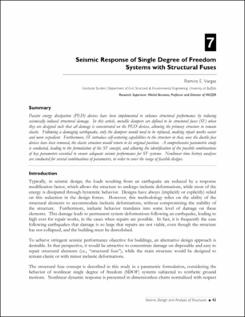Seismic Response of Single-Degree-of-Freedom Systems with Structural Fuses
Abstract
Passive energy dissipation (PED) devices have been implemented to enhance structural performance by reducing seismically induced structural damage. In this article, metallic dampers are defined to be structural fuses (SF) when they are designed such that all damage is concentrated on the PED devices, allowing the primary structure to remain elastic. Following a damaging earthquake, only the dampers would need to be replaced, making repair works easier and more expedient. Furthermore, SF introduce self-centering capabilities to the structure in that, once the ductile fuse devices have been removed, the elastic structure would return to its original position. A comprehensive parametric study is conducted, leading to the formulation of the SF concept, and allowing the identification of the possible combinations of key parameters essential to ensure adequate seismic performance for SF systems. Nonlinear time history analyses are conducted for several combinations of parameters, in order to cover the range of feasible designs.
Collections
Related items
Showing items related by title, author, creator and subject.
-
Seismic Response of Single-Degree-of-Freedom (SDOF) Structural Fuse Systems
Vargas, Ramiro; Bruneau, Michel (2004-06-26)Passive energy dissipation (PED) devices have been implemented to enhance structural performance by reducing seismically induced structural damage. In this paper metallic dampers are defined to be structural fuses (SF) ... -
Floor Response of SDOF Systems with Metallic Structural Fuses
Vargas, Ramiro (2004-06-26)The floor demands of Single-Degree-of-Freedom (SDOF) systems designed or retrofitted with metallic structural fuses are studied in this article. Floor velocity and acceleration are obtained and comparisons are made between ... -
Seismic Design of Multi-story Buildings with Metallic Structural Fuses
Vargas, Ramiro; Bruneau, Michel (2006-06-28)Seismic design relies on inelastic deformations through hysteretic behavior. However, this translates into damage on structural elements, permanent system deformations following an earthquake, and possibly high cost for ...
